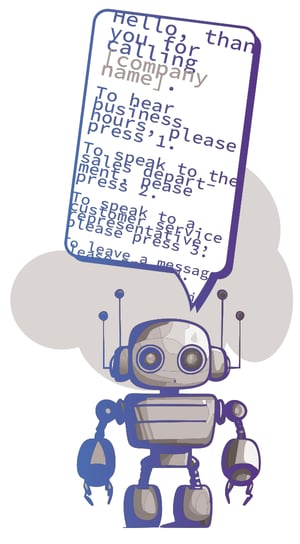Six Misconceptions About AI Virtual Agents in Customer Service
The use of conversational artificial intelligence (AI) technology in contact centers is growing, and with good reason. More than 85% of customers expect businesses to offer a self- service solution, meaning that organizations must implement intelligent virtual agents (IVAs) to support contact centers to stay ahead of customer demands.
What is an IVA?
An IVA is an AI-enabled communication tool that generates personalized responses to users through natural language processing (NLP). NLP is a branch of AI that helps computers understand, interpret, and manipulate human language.

IVAs differ from typical chatbots and textbots due to their ability to closely resemble human speech. They can provide customers with a service experience nearly indistinguishable from a human agent. They can also handle a wider range of requests. While chatbots are mostly used for FAQ and account-related tasks, IVAs can handle certain actions that used to require human assistance, like processing returns or submitting an insurance claim.
Streamline customer service request, so human agents only need to address the most complex customer service problems.
The benefits of adopting IVA technology are numerous. For one, automation allows contact centers to streamline customer service requests, so human agents only need to address the most complex customer service problems. (For example, an IVA can help airline customers book flights using travel funds, but a human agent can decide if a customer can extend the expiration date of those funds due to personal circumstances.) Second, IVAs grant customers access to 24/7 support on their own terms through self-service solutions. Finally, the use of IVAs results in greater satisfaction and retention, both for customers and contact center agents. Contact center agents will be better able to handle higher priority, complex calls, and customers will immediately get the support they need.
However, even with all the above benefits, stakeholders are hesitant to use IVAs. This eBook examines six misconceptions IT decision makers have about adopting IVAs and sets the record straight.
Misconception #1 – Consumers Don’t Like Virtual Agent Customer Service
When a customer has a problem with a product or service, they want someone to answer the phone immediately and assist them.
Unfortunately, calling customer service can sometimes be tedious and frustrating. Long wait times caused by decreased contact center staffing can make customers even more upset. Receiving help from a human customer service agent may seem ideal over an IVA answering the phone, but statistics say this shouldn’t be a problem for most customers. According to an American Express survey, 60% of customers in the U.S. prefer automated self-service technology over speaking with a customer service agent.
Advanced conversational automation powered by AI will reduce athe burden on the contact center.
Contact centers can address long wait times and decreased human agent staffing with IVAs. Virtual agents are programmed to answer calls immediately, with no wait time necessary. The speed and ease provided by IVAs can foster better customer experiences, increase customer retention, and boost overall brand loyalty. Positive sentiments toward an organization improve when customers can receive support right away, regardless of what type of agent is answering the phone.
Misconception #2 – AI Agents are too Expensive
Technology is complex, and this complexity can appear synonymous with high costs. Introducing a new technology like conversational AI can be a significant business investment. The high upfront costs associated with installing technology and training contact center agents have the potential to dissuade organizations from purchasing.
- 85%
- customers expect businesses to offer a self-service solution.
Source: Statista
While overhead costs due to AI implementation may be high, the immediate benefits to contact center staffing and the long-term savings provide an ROI significantly higher than implementation costs. Statista predicted that in 2022, the implementation of AI agents throughout business operations could generate $0.89 trillion in business value.
For contact centers, the cost savings associated with IVA implementation are significant. As IVAs provide customer service 24/7, businesses can save money on contact center staffing, especially in overtime pay.
Additionally, IVAs can generate revenue through personalized lead nurturing, sending customers emails about relevant business offerings.
Not only does AI generate business value, but it is also predicted to give back 6.2 billion hours of worker productivity, according to Gartner. This time back allows human contact center agents to focus on more complex customer service requests and improve work/life balance due to better staffing.
Finally, businesses may be concerned about the prices associated with operating IVAs daily, not just the initial overhead costs. However, they will be happy to know that IVAs are paid for per productive hour, so businesses using virtual agent software only pay for the hours when the technology is active. This allows organizations to utilize the technology only when contact center agents are unavailable.
Misconception #3 – Virtual Agent Software Lacks Empathy and Accuracy
When experiencing a product or service issue, customers want compassion and understanding. The concern with IVAs is that they may be unable to express empathy toward customers, resulting in frustration and decreased customer satisfaction.
However, IVAs are explicitly designed to be as human-like as possible through AI and machine learning (ML). Technology providers know that stakeholders value human connection and work hard to develop sophisticated technology that can provide the most authentic customer service experience. In fact, a study conducted by the University of Florida found that 63 out of 172 respondents were unable to distinguish between a human agent and an AI chatbot during a customer service interaction.
IVAs can understand the content and intonation of what a customer says, and the context of the customer’s inquiry. Through NLP, virtual agents can handle a complex range of questions and interactions, demonstrating the sense of empathy and personalization that customers crave. While a response may be coming from a computer, it is using cutting-edge technology to understand both customer requests and the emotion behind the request.

Misconception #4 – AI Virtual Agents Cannot Maintain Client Relationships
Meaningful and positive customer experiences lead to long-term client relationships, and, as business leaders know, these relationships turn into repeat purchases and increased brand loyalty. Some people believe that only human contact center agents can cultivate and maintain client relationships, but that isn’t true.
IVAs can go the extra mile for customers through personalization. IVAs help businesses nurture leads and support customers with tailored follow-ups and communications throughout the client relationship. For example, if an IVA sees that a customer has a payment coming up or identifies a purchase opportunity that fits a customer profile, it can send a message letting the customer know and providing the next steps. Enhanced personalization is a valuable customer service tool to maintain client relationships.
Misconception #5 – Virtual Agent Software Will Replace Human Agents
Automation can seem intimidating. We have all seen movies like “WALL-E,” “The Terminator,” and “2001: A Space Odyssey,” where robots replace humans, having outgrown the need for human support (sometimes to our detriment). In fact, 27% of workers say they are worried that AI technology will eliminate the need for their current job, according to CNBC. But when it comes to IVAs, that’s just science fiction.
- 6.2B
- hours of woker productivity given back by AI
Source: Gartner
The goal of IVAs is not to replace human agents. IVAs are an addition to a contact center, not its entirety. Contact centers use IVAs to allow human agents to focus on more complex customer service requests. Complex tasks include disputing a charge, answering personal questions about products and services, and providing tech support (after turning it off and on again). IVAs are a huge help to contact center staff, not a threat to job security. According to the Augmented Human Enterprise study , 70% of respondents said that AI technology improved the wellbeing of their teams and 80% said that AI allows them to avoid repetitive work.
Additionally, and unlike science fiction movies, IVA technology needs human IT support for training and programming. A human expert is required to tailor an IVA to meet specific business needs. Without human workers, IVAs cannot exist.
Misconception #6 – Any Virtual Agent Will Suffice

There are a lot of conversational AI solutions on the market, and through branding, it may seem like they all offer the same level of service. But that is not true.
Not all contact center automation technology is created equal. Through ML and NLP, some virtual assistant software is more sophisticated than others. This is apparent when looking at IVA solutions versus interactive voice response (IVR) solutions. These two communication tools have a big difference.
IVR is a tool that automates interactions and increases first-time resolutions through touch-tone key selections and voice commands. Customers interact with IVR through a series of menus that help the technology gather customer information and then direct the customer to the most appropriate help for their needs.
While this sounds like an IVA, there are key differences. Most importantly, IVR does not use AI and is less sophisticated than an IVA. As you can see from the above interaction, there is no conversation happening. The IVR acts as a directory. Instead of presenting customers with menu options, an IVA simply asks, “How can I help you?” Customers can speak freely with the virtual agent to view account balances, make payments, and schedule appointments, among other actions.
It only takes minutes to update customer data for predictive intent with near real-time machine learing.
Contact centers need to be strategic with the virtual agent tools they select and treat the IVA selection process the way they would when hiring a new employee. Before deciding which conversational solution to deploy, companies should identify the communication needs at hand to clearly understand what solution is correct. Additionally, when vetting options, it’s wise to examine customer testimonials, review the available integrations, and request a demo of the solution.
Meet Mosaicx
If you’re renewing or revamping customer engagement strategies this year or next, now is the time to meet Mosaicx. Hear a demo of Mosaicx conversational AI as it helps one of our team members pay a bill. Or you can connect with an expert to learn more.
8 min read
12 Call Center Metrics You Should Be Using to Improve CX in 2025
Apr 17, 2025
8 min read
What's CSAT Score? How to Measure and Improve It
Apr 14, 2025
